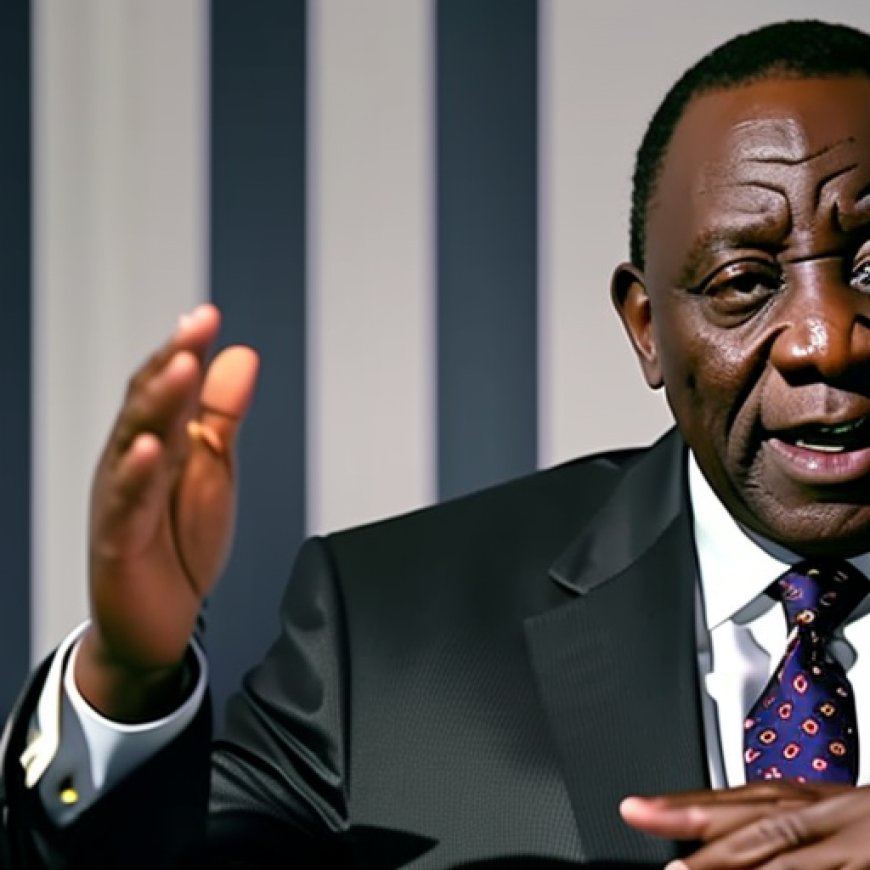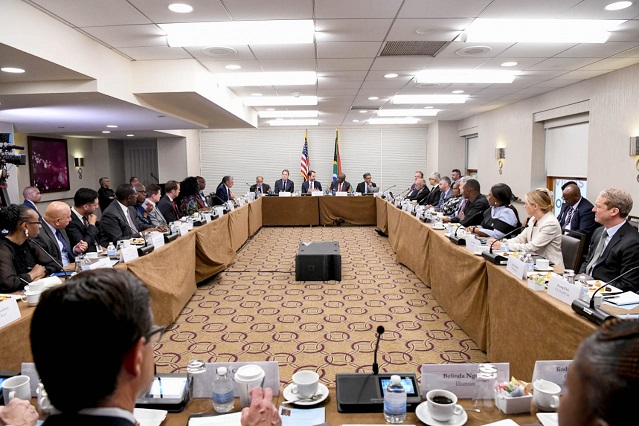US Chamber of Commerce hosts Ramaphosa to deepen bilateral trade, investment ties – SABC News
US Chamber of Commerce hosts Ramaphosa to deepen bilateral ... SABC News


The U.S. Chamber of Commerce Hosts U.S.-South Africa Trade and Investment Executive Dialogue

The U.S. Chamber of Commerce is organizing a record number of meetings and events on the sidelines of the 78th session of the UN General Assembly (UNGA) to help foster public-private collaboration and underscore the indispensable role of the private sector in realizing the UN’s global targets. As part of this effort, the U.S. Chamber’s US-Africa Business Center (USAfBC) hosted the U.S.-South Africa Trade and Investment Executive Dialogue with the President of the Republic of South Africa Cyril Ramaphosa.
US Chamber of Commerce hosts President of South Africa to deepen Bilateral Trade and Investment Ties #InvestSA https://t.co/UaIIkpK172 pic.twitter.com/8LCxDE1omO
— Presidency | South Africa (@PresidencyZA) September 18, 2023
President Ramaphosa’s Call for Increased Investment
President Ramaphosa expressed his satisfaction with the presence of over 600 U.S. businesses operating in South Africa, highlighting the country’s status as the most industrialized and diversified economy in Africa. He welcomed the productive discussions on the U.S.-South Africa economic relationship facilitated by the U.S. Chamber of Commerce. President Ramaphosa invited more U.S. companies to invest in South Africa, emphasizing the opportunities available in the country’s economy and the fast-growing African market. He also wished success to the partnership between the U.S. Chamber and Business Unity South Africa (BUSA) in strengthening economic bonds and expanding South Africa’s role as an economic hub in Africa.
Partnership Efforts for Trade and Investment
The dialogue, hosted in conjunction with BUSA, built on the partnership efforts outlined in the Memorandum of Understanding between the organizations. The event included the launch of an annual U.S. Chamber-BUSA South Africa-US Trade and Investment Forum. The discussions focused on identifying actionable strategies to enhance commercial ties between the United States and South Africa.
We’re on the ground at the 78th annual @UN General Assembly to underscore the indispensable role of the private sector in realizing the UN’s global targets. Here’s how businesses are shaping solutions in climate, health, global economic growth, and more: https://t.co/0oCAO3ApGk
— U.S. Chamber (@USChamber) September 18, 2023
Accelerating Economic Growth
The President of the U.S. Chamber, Scott Eisner, reiterated the organization’s commitment to doubling U.S. commercial and foreign direct investment in South Africa by 2025. He praised the collaborative spirit of the dialogue, which focused on “An Agenda for Accelerating Economic Growth.” President Eisner expressed gratitude for President Ramaphosa’s vision for the U.S.-South Africa commercial partnership and his support for the U.S. Chamber and BUSA’s initiative to establish a yearly South Africa-U.S. Trade and Investment Forum. He also mentioned the upcoming United States-Sub-Saharan Africa Trade and Economic Cooperation Forum (AGOA Forum) meeting in South Africa this November as an opportunity to further strengthen the partnership.
BUSA Ready for Investors
BUSA CEO Cas Covaadia emphasized the ripe opportunity for U.S. and international investors to contribute to South Africa’s growth efforts through a partnership between business and government. He highlighted the aim of the dialogue to put the country on a sustainable growth path and optimize its potential. The MOU between BUSA and the U.S. Chamber, along with the launch of the South Africa-US Trade and Investment Forum, demonstrates the importance of partnership in promoting shared growth and prosperity. BUSA stands ready to support investors entering the South African market.
During the UNGA from September 18-22, the U.S. Chamber is leading over 24 high-level conversations with top government representatives, including heads of state and government, from countries such as Brazil, Nigeria, South Africa, and Türkiye.
Watch the US-SA Executive Dialogue
[embedded content]
Share article
SDGs, Targets, and Indicators Analysis
1. Which SDGs are addressed or connected to the issues highlighted in the article?
- SDG 8: Decent Work and Economic Growth
- SDG 17: Partnerships for the Goals
The article primarily focuses on economic growth, trade, and investment between the United States and South Africa. SDG 8 aims to promote sustained, inclusive, and sustainable economic growth, full and productive employment, and decent work for all. SDG 17 emphasizes the importance of partnerships and collaboration to achieve the sustainable development goals.
2. What specific targets under those SDGs can be identified based on the article’s content?
- SDG 8.1: Sustain per capita economic growth in accordance with national circumstances and, in particular, at least 7 percent gross domestic product growth per annum in the least developed countries.
- SDG 8.2: Achieve higher levels of economic productivity through diversification, technological upgrading, and innovation.
- SDG 17.16: Enhance the global partnership for sustainable development, complemented by multi-stakeholder partnerships that mobilize and share knowledge, expertise, technology, and financial resources.
The article mentions the goal of doubling US commercial and foreign direct investment in South Africa by 2025, which aligns with SDG 8.1. It also highlights the importance of economic growth and productivity enhancement, which relate to SDG 8.2. Additionally, the partnership between the U.S. Chamber of Commerce and Business Unity South Africa (BUSA) reflects the spirit of SDG 17.16.
3. Are there any indicators mentioned or implied in the article that can be used to measure progress towards the identified targets?
- Indicator for SDG 8.1: Gross domestic product (GDP) growth rate
- Indicator for SDG 8.2: Economic productivity index
- Indicator for SDG 17.16: Number of multi-stakeholder partnerships formed
The article does not explicitly mention specific indicators. However, GDP growth rate can be used as an indicator for measuring progress towards SDG 8.1. Economic productivity index can be used to assess progress towards SDG 8.2. The number of multi-stakeholder partnerships formed can serve as an indicator for measuring progress towards SDG 17.16.
Table: SDGs, Targets, and Indicators
| SDGs | Targets | Indicators |
|---|---|---|
| SDG 8: Decent Work and Economic Growth | 8.1: Sustain per capita economic growth in accordance with national circumstances and, in particular, at least 7 percent gross domestic product growth per annum in the least developed countries. | Gross domestic product (GDP) growth rate |
| SDG 8: Decent Work and Economic Growth | 8.2: Achieve higher levels of economic productivity through diversification, technological upgrading, and innovation. | Economic productivity index |
| SDG 17: Partnerships for the Goals | 17.16: Enhance the global partnership for sustainable development, complemented by multi-stakeholder partnerships that mobilize and share knowledge, expertise, technology, and financial resources. | Number of multi-stakeholder partnerships formed |
Behold! This splendid article springs forth from the wellspring of knowledge, shaped by a wondrous proprietary AI technology that delved into a vast ocean of data, illuminating the path towards the Sustainable Development Goals. Remember that all rights are reserved by SDG Investors LLC, empowering us to champion progress together.
Source: sabcnews.com

Join us, as fellow seekers of change, on a transformative journey at https://sdgtalks.ai/welcome, where you can become a member and actively contribute to shaping a brighter future.







